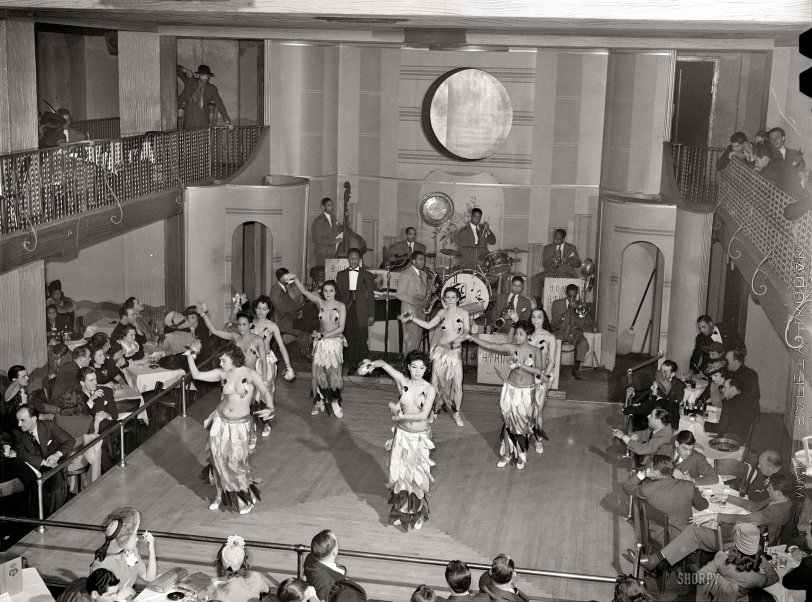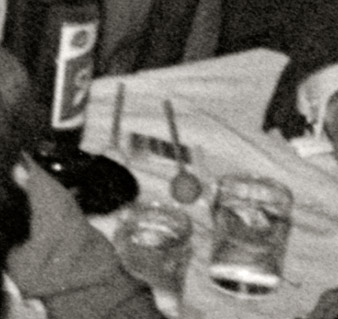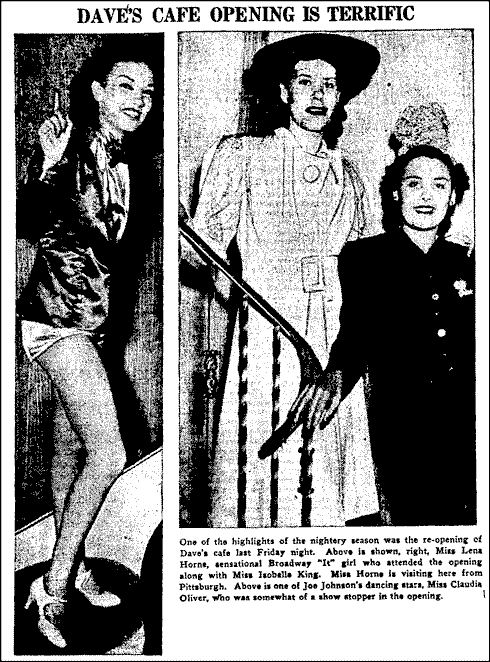


Framed or unframed, desk size to sofa size, printed by us in Arizona and Alabama since 2007. Explore now.
Shorpy is funded by you. Patreon contributors get an ad-free experience.
Learn more.

- Exclusive pump
- Details, Details
- What's that building to the left of the tower?
- Coal Barges
- Bromo-Seltzer
- Inner harbor
- The Basin
- What a headache!
- Giant stepladder?
- Baldwin 62303
- Baldwin VO-1000
- Cold
- No expense spared
- Tough Guys
- Lost in Toyland
- And without gloves
- If I were a blindfolded time traveler
- Smoke Consumer Also Cooks
- Oh that stove!
- Possibly still there?
- What?!?
- $100 Reward
- Freeze Frame
- Texas Flyer wanted
- Just a Year Too Soon
- WWII -- Replacing men with women at the railroad crossing.
- Yes, Icing
- You kids drive me nuts!
- NOT An Easy Job
- I wonder
Print Emporium
Negro Cabaret: 1941

April 1941. "Negro cabaret, South Side Chicago." The Boyd Atkins Band. Acetate negative by Russell Lee for the Farm Security Administration. View full size.
Swingland
This was at 343 E. 55th Street near Washington Park. Other names for the club were Swingland Cafe (1938 at least) and Rhumboogie (April 1942 to 1947). Building looks to be long gone.
Boyd Atkins
Atkins (standing with sax) seems a rather obscure figure considering his illustrious associations -- playing in Fate Marable's legendary band steaming up and down the Mississippi at the end of the 1910s, then with Louis Armstrong in the 1920s, etc. in addition to leading his own bands. Trombonist Kid Ory, in a 1957 interview, recalled playing in Boyd Atkins band in Chicago in the 1920s when two rival gangs of Chicago gangsters opened fire on each other. I wonder if the venue was similar to this one.
The beer that gave Milwaukee the Schlitz!
Thanks for the close-up on the knockers because I see a bottle of Schlitz beer. You know, it was brewed with just a kiss of the hops, not the harsh bitterness. Just saying.
"Lollipops"
Those are noisemakers called knockers. There would be one for every patron at the table. They were struck against the table (if unclothed) or mostly on the glassware. It was used as an applause mechanism by the celebrants. At New Year's Eve events they were, like the funny hats, expected accoutrements. Usually embossed with the venue's name & address, they were taken home as souvenirs of a night out.
Lollipops?
It seems, that there are lollipops on some tables. Were they popular at that time?
[More like little xylophone mallets. To tap out your applause or perhaps to stir your cocktail. - Dave]

Clarification
*SIGH!* I meant "except for the African Americans in the audience." Thanks to those who corrected me. I was surprised to see brown skin even at back tables and in the upstairs. As someone who wouldn't want to sit at a strip club, either, I find it VERY weird how many women are with the men watching the dancers. Wouldn't that feel just awkward, especially back then!? Apparently not.
[This is your standard mid-century nightclub floor show. Pretty much gone with the wind except maybe in Vegas. - Dave]
South Sider
This photo predates me by a couple of years. I was raised on the South Side of Chicago and would love to know where this photo was taken.
Club Glum
There is not one person smiling as the photographer clicks the shutter. Not one. Not even the dancers.
This photo could hardly be used as an advertisement for having a fun night out!
Cotton Club audience
It was said: How very Cotton Club it all seems (except for the Caucasian people in the audience).
The audience at the Cotton Club was Caucasian.
Black and Tan
How very Cotton Club it all seems (except for the Caucasian people in the audience).
Blacks were usually barred from the Cotton Club, except as performers.
Looking through the Defender archives, I ran into the term "black and tans" a lot, for black and white bars. Without black customers, I don't know if the Cotton club qualified. A mixed audience may have been progressive at the time, but notice who gets all the front seats, and who's restricted to the back rows and the balcony.
Salad of the Bad Cafe
I got food poisoning once from the shrimp salad at a place just like this!
Cotton gin mill
How very Cotton Club it all seems (except for the Caucasian people in the audience). The expressions on the faces of the dancers are very... distant. Many of these old timey dance pictures show girls with bright, lipsticked smiles. These expressions seem to range from concentration to disdain.
Dave's Cafe
I think I found the place. This is absolutely the right area, the right era and the right aura. Lena Horne is leaning on a railing that matches the Shorpy photo and it looks like "show stopper" Claudie Oliver is the front dancer. Interesting that the Chicago Tribune had exactly zero references to band-leader Boyd Atkins from 1930 to 1960. The great South Side black paper, The Chicago Defender, had dozens.
The Chicago Defender, September 14, 1940 - Joe Johnson's Production Is Hot Harlem Done Up in 'Chi' Bronze
What Little Ziggy Johnson has done for Dave's Cafe a-la floor show is more than patrons expected, even more from Ziggy. Johnson has some names; lots of dance, fine singing and a beauty line you find worthy of a rave. But even better yet, my friends, Little Ziggie has surrounded himself with such well-known artists as: Ted Smith, a radio star with the silver toned voice; Maxine Johnson, sweet singing Canadian songbird; Leroy "Pork Chop" Patterson, three hundred pounds of mirth and melody; Spizzie and George, a pair of clever dancers that have everything that the public wants and then those nationally-known society dancers, Johnson and Grider, a mixed team of terpsichoreans that display art with every move.Margie Smith, Bea Rhinehart, Arrabelle Martin, Ollie Dell Southern, Harriett "Hickey" Hickerson, Cecelia Jones, Mammie Morton and Claudie Oliver are the eight shapely line girls. one of the girls, Claudie Oliver, shows exceptional cleverness as she tags the finale "Tuxedo Junction." Boyd Atkins and his music master add the final touch to a show well worth seeing.
Anyone got a time machine?
I need to go back and meet the dancer in front on the right.
Black and white
Just about any nightclub on the South Side would have been considered "Negro" at the time -- the owner was probably black, it was in a famous black neighborhood, and most if not all of the name talent was black. Which isn't to say you wouldn't find lots of white folks there -- "slumming" had been considered fashionably adventurous well before the advent of swank watering holes like this.
Probably Peoria
If it's 1941, it's more than likely this is Boyd Atkins fronting the Society Swingsters in Peoria.
[This is a Chicago nightclub. Doesn't anyone read the captions? - Dave]
Boyd Atkins
Saxophonist and bandleader. Wrote "Heebie Jeebies," which as recorded by Louis Armstrong was one of the first hit songs to feature scat singing.
Swept away
Hey, we're trying to make a classy photo up here. Someone get that broom and the thingamabob outta that little room there. What's folks gonna think in 2009?
Various Patrons
Interesting that most of the customers are white. The zoot-suited hepcat on the balcony looks like one of Will Smith's ancestors.
Swanky Joint
Makes me want to go out and buy a suit and tie. And start smoking.

























On Shorpy:
Today’s Top 5